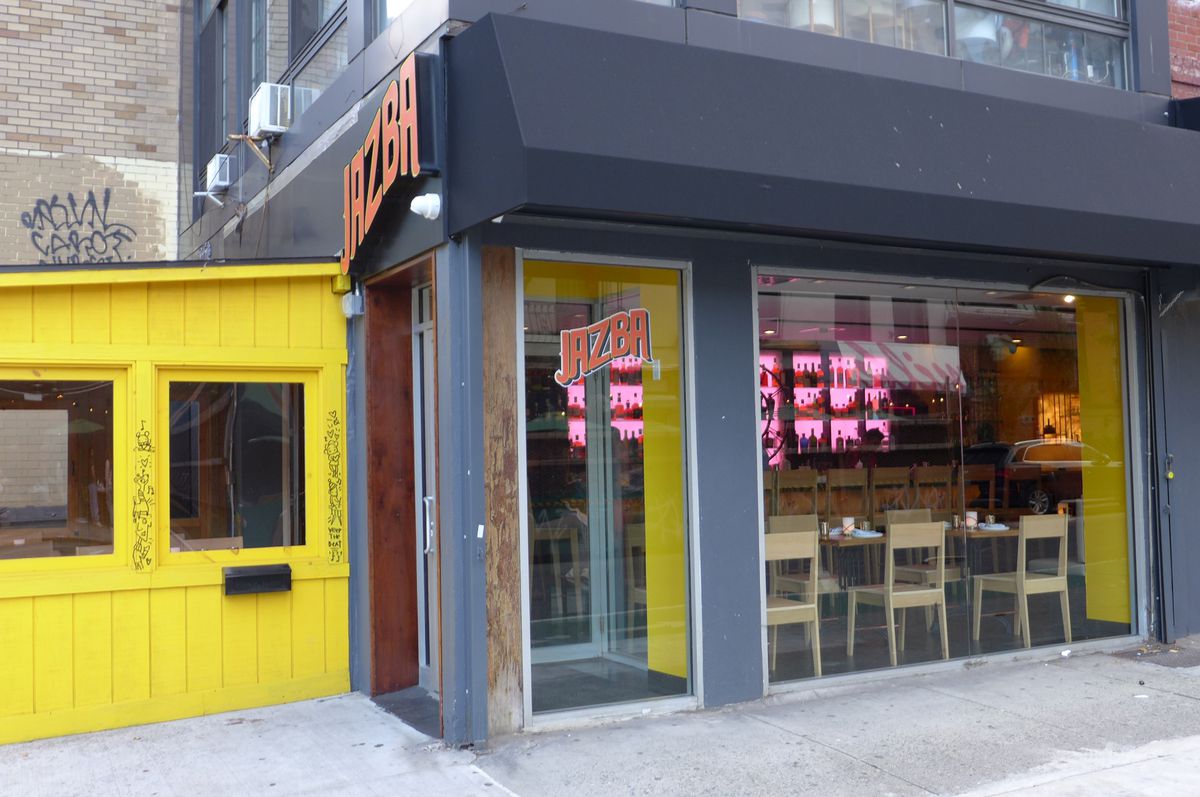When we look back on this decade, we may remember it as the era of regional Indian food. It’s a similar differentiation of what’s been happening the past decade with Chinese cuisines, with ambitious new restaurants popping up in far-flung neighborhoods, offering regional dishes rarely served in New York City restaurants before.
Jazba (meaning “passion” in Urdu) is a prime example of the rise of regional Indian cuisines across the city. The restaurant opened two weeks ago at 207 Second Avenue and 13th Street, in the space that was formerly the legendary Momofuku Ssam Bar. The chef is Akshay Bhardwaj of Junoon, and the new place promises to showcase the street food found in India’s dhabas, roadside shacks.


Jazba is flamboyantly decorated, with colorful cartoon murals of street carts along one wall, brightly lit booze bottles behind the bar, and an enclosed porch painted a bright yellow, so you won’t miss it while stuck in traffic on Second Avenue. The menu is arranged by “half ticket” and “full ticket” with an array of dishes with references to Hyderabad, Vishakhapatnam beach shacks, “North Indian cities”, Goa, and others: I decided to focus on menu items credited to Mangalore, a bustling port city of around 700,000 on the Arabian Sea in the state of Karnataka, just south of Goa. One such dish is pandi curry ($34), and the menu attributes it more specifically to Coorg, a rural district southeast of Mangalore where wild boar hunting in olden times is said, by the menu at least, to have inspired the dish.
I brought with me an Indian American friend whose grandfather had owned a coffee plantation in Karnataka, and he told me that his mother made this curry at home in Houston all the time. “Pandi” just means pork he told me, a meat not usually served in Indian restaurants here, but at least partly owing in this context to the historic Catholic population of Mangalore, and Portuguese influence up and down the coast. On the menu, katchampuli is mentioned as a prime ingredient, which my friend described as date vinegar, though the identity may be more complex.

When the dish arrived, it featured nice chunks of fat-rimmed pork belly (though maybe not enough at the price), in a dark and dense gravy that glistened and packed quite a bit of heat. We found it tasty, though my friend missed the intriguing sour and fruity flavor his mother’s version had.
The pandi curry came sided with steamed Chinese bao, perhaps in a sly reference to Momofuku Ssam Bar, for which such folded buns stuffed with pork belly were a signature item. The pandi curry left my friend promising to fly his mother’s version back on his next trip home, but we agreed later that, sufficiently sour or not, it was the second best of the six dishes we tried on a first visit to Jazba.
The best was certainly the green chili chicken ($34). The menu claims the recipe comes from a roadside shack in the Rayalaseema region of Telangana (other sources link it to Andhra Pradesh). Curry leaves and Thai chiles make up the thick green slurry that engulfs the bone-in chicken. The sauce is delicious and super spicy, and the dish is sided with jeera rice and appam — a snowy, bowl-shaped flatbread made with fermented rice popular in far southern India. This bread is beyond wonderful, but we really needed several more to sop up all the sauce, though the rice also helps.


Credited to a railway station in the northern Indian state of Rajasthan, the warm, beige-colored sauce that comes with the onion-stuffed fritters called kachori ($16) is laced with buttermilk, and so mellow and subtly spiced I found myself drinking the extra sauce like a soup. Unfortunately, the fritters themselves were cold and hard.

Much better was another half ticket from Mangalore, fried chicken ($18) in a paper nest that came with excellent sauces of pickled mango and red chile. “Now this is real Indian street food,” my friend exclaimed enthusiastically. The worst dish we had was a seafood biryani said to come from the southern coast of India. It sported squid rings cooked to over-chewy oblivion along with hunks of seafood difficult to identify, and a dark-colored rice from which little flavor emerged. Given the majesty of much biryani currently found here and its attention to nuanced flavors, this was a disappointment.
We were reinspired by the kulfa ($13) on the dessert menu, which really incorporates several desserts in yellow, off-white, and pinkish hues. Included were saffron-flavored noodles, frozen coconut kulfi, rice pudding, and basil seeds that looked like little eyes. Altogether wonderful, and it left us vowing to return, if only to check out the veal chop for two ($69) attributed to a restaurant in Delhi.

